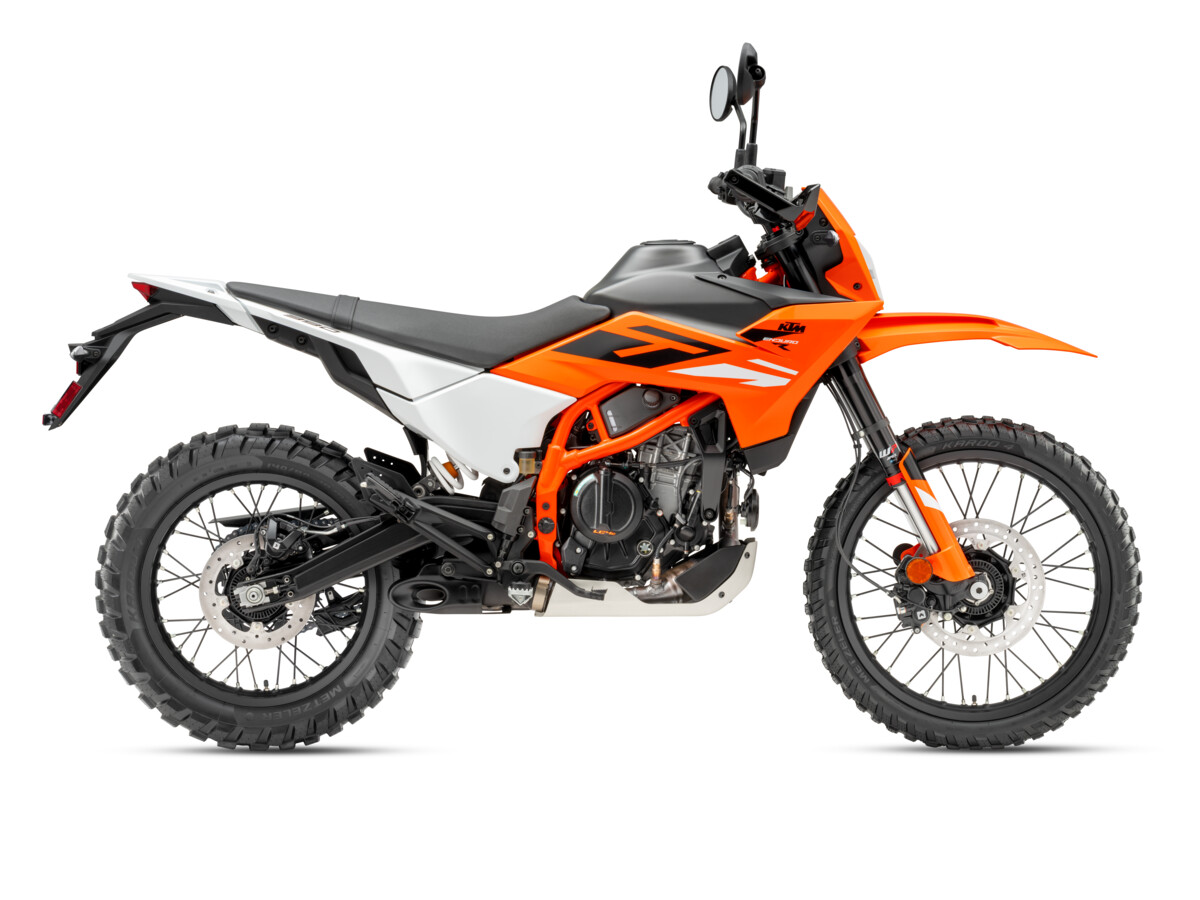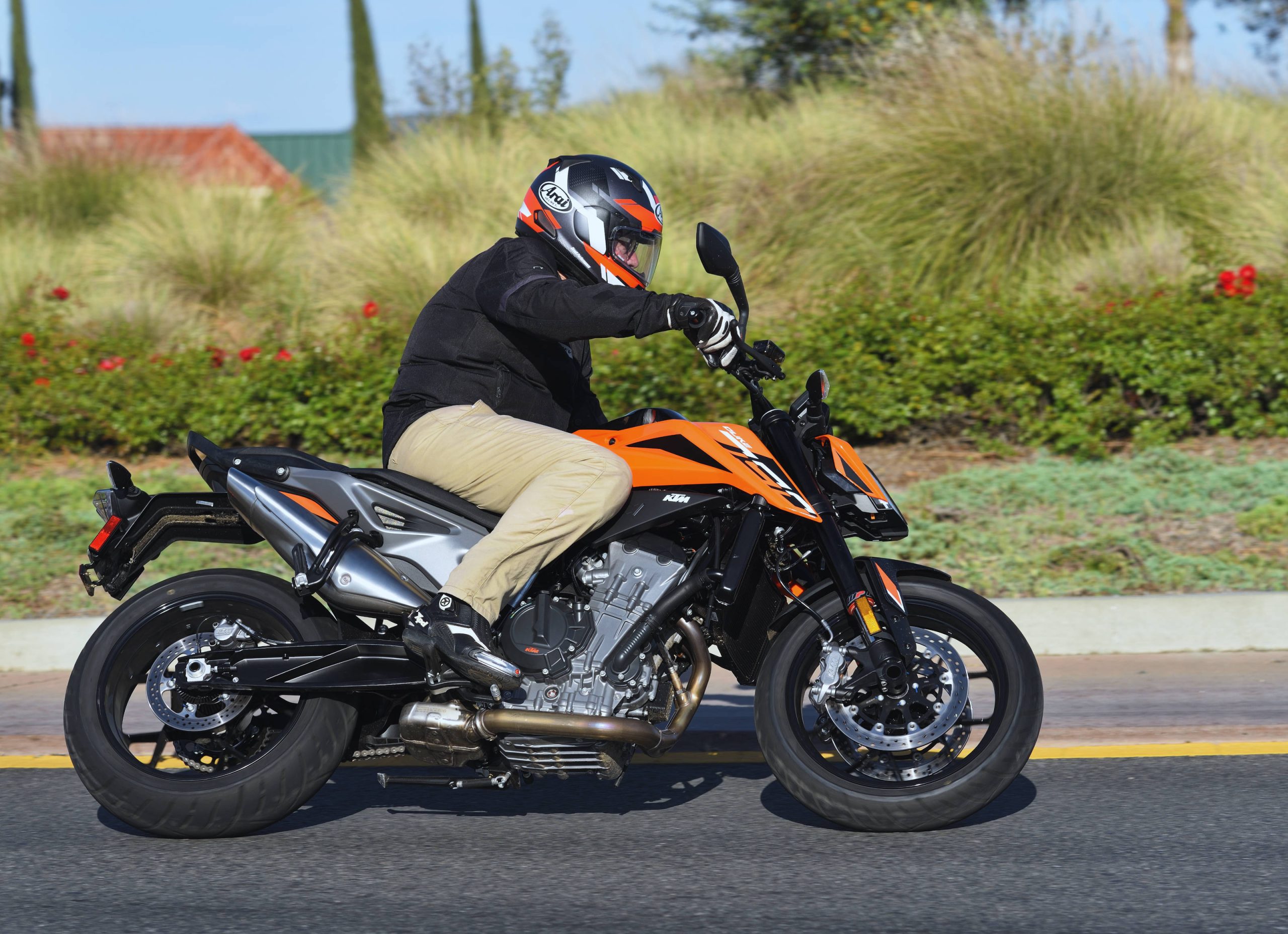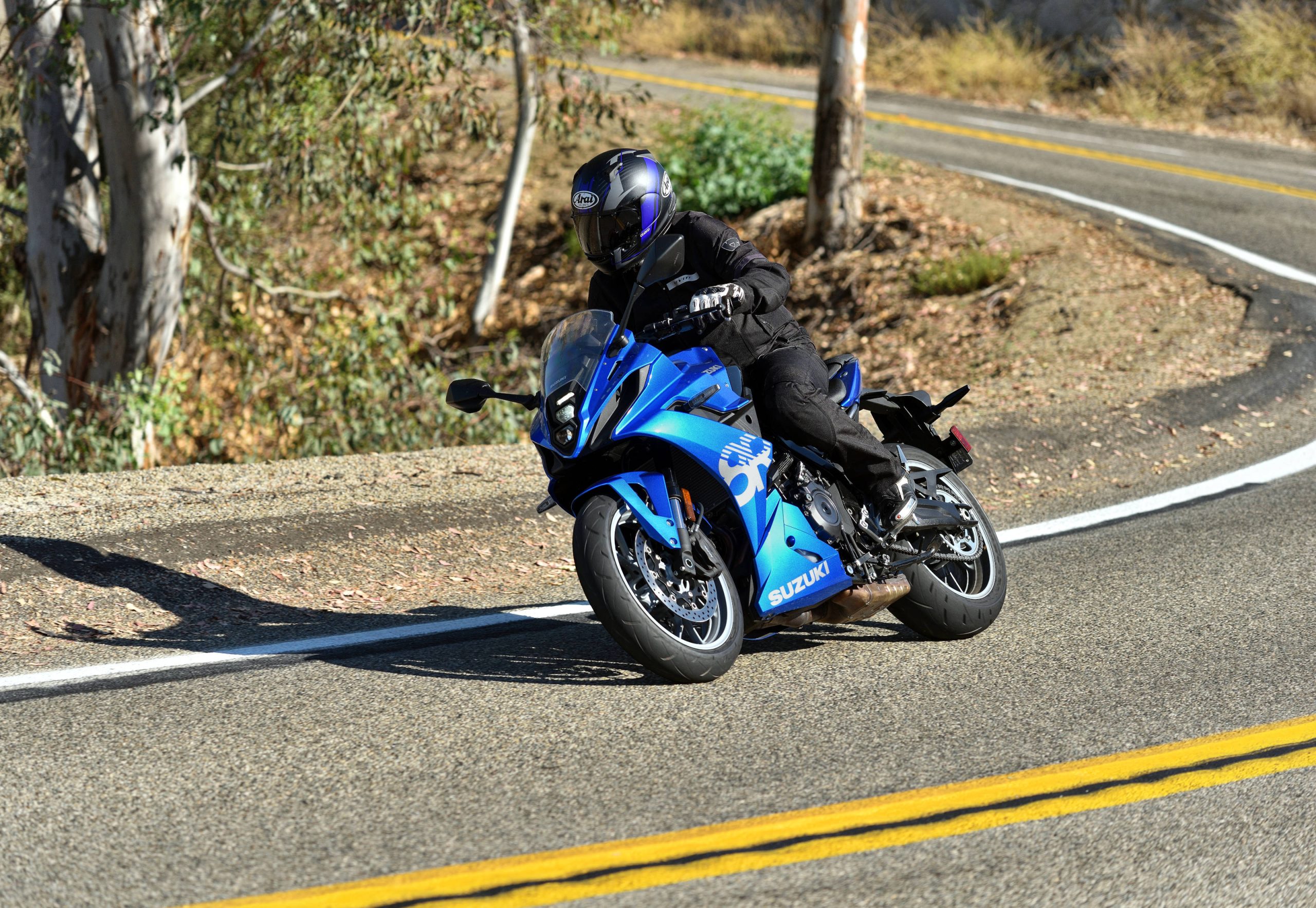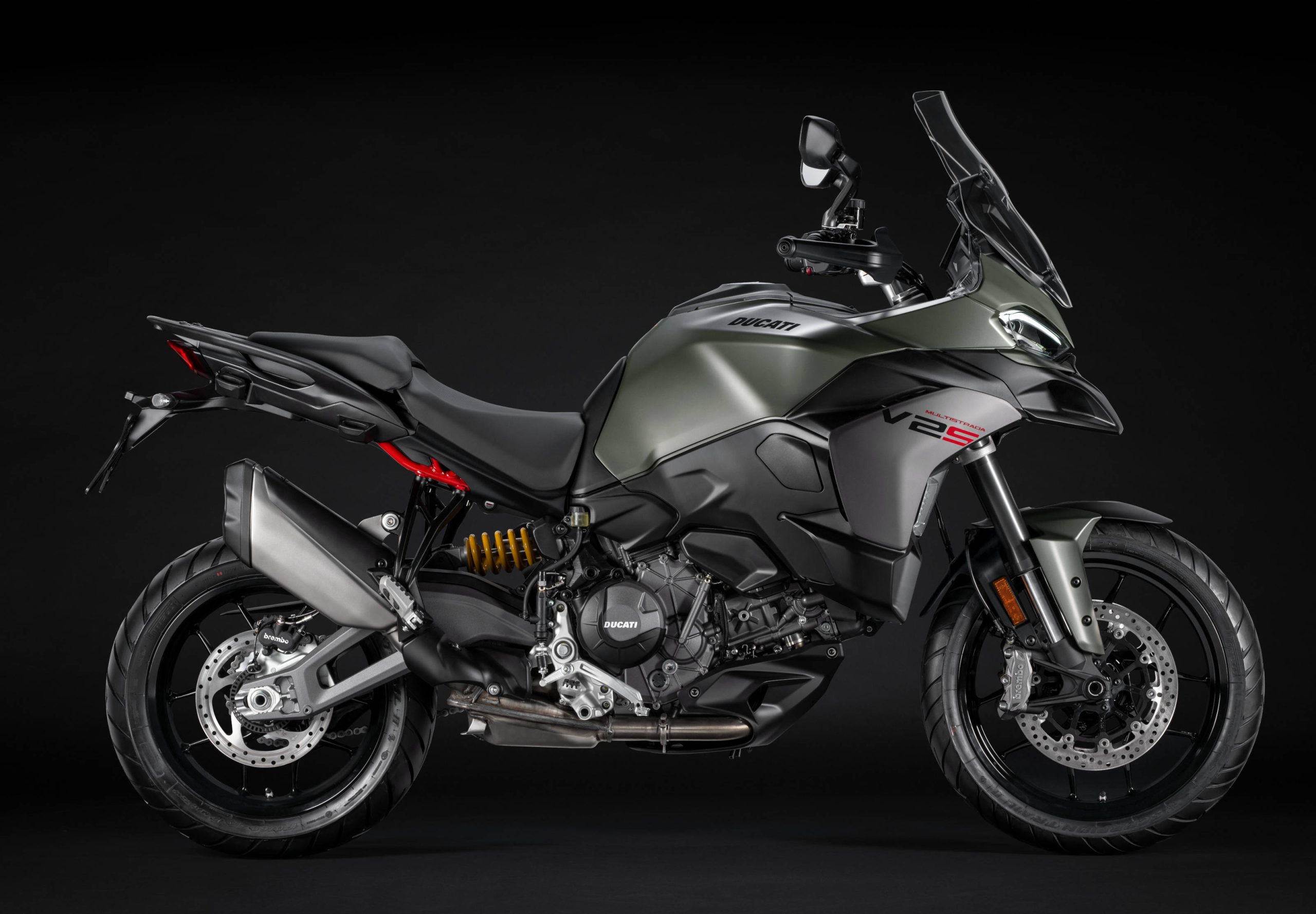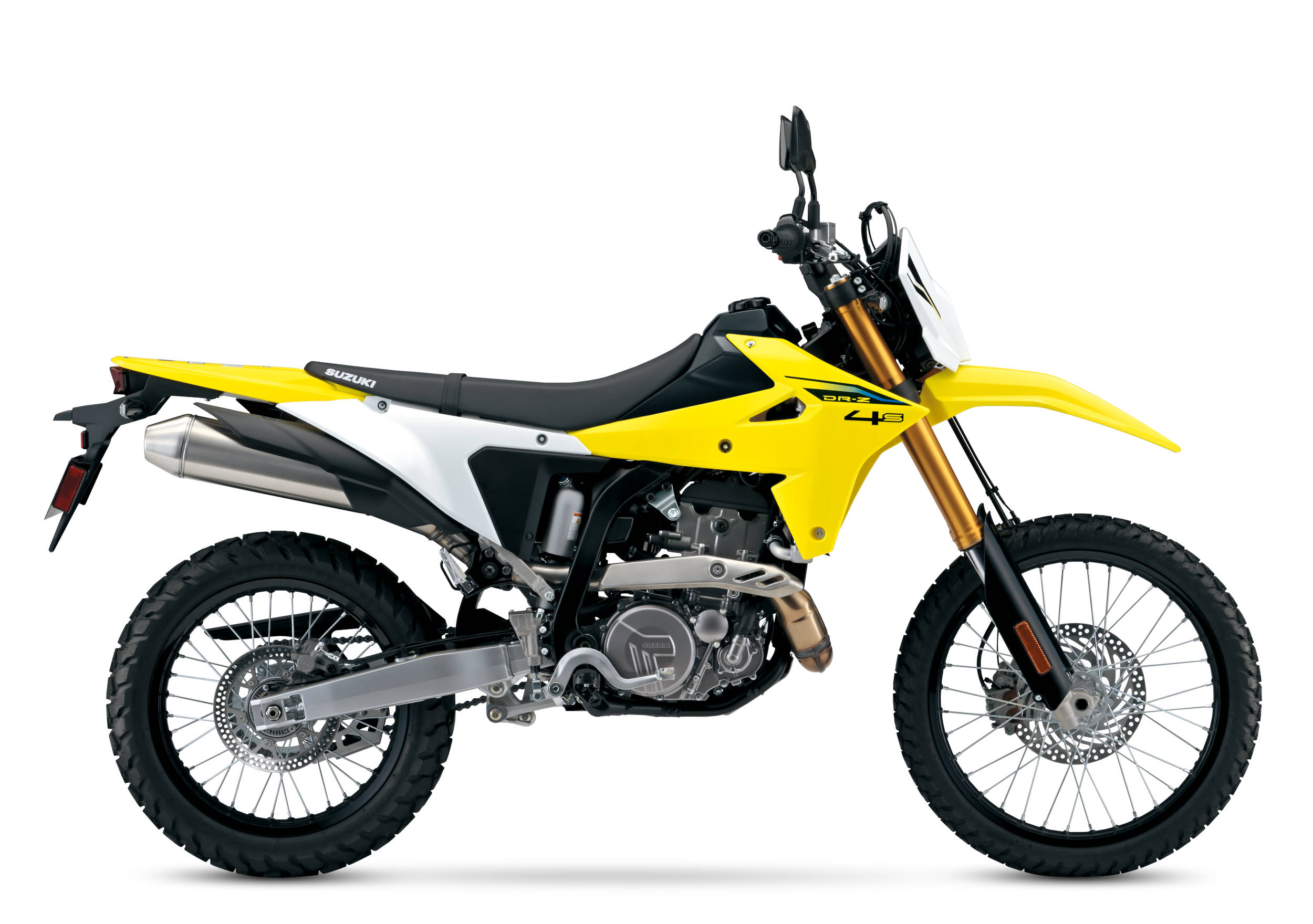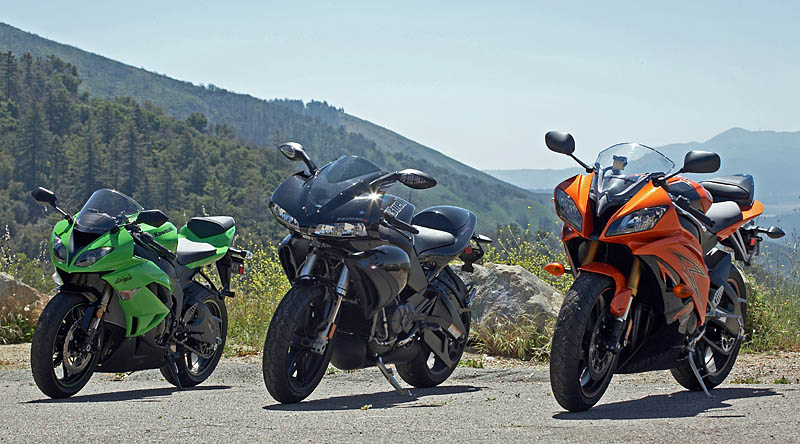
It seems like a lot of folks are unhappy with the new Daytona Sportbike class. Designed to provide close racing action on minimally modified middleweight sportbikes, it was the class for 2009’s Daytona 200, replacing last year’s Formula Xtreme. Instead of setting up a complex formula, AMA officials made a list of 10 different models deemed competitive based on “weight and performance characteristics that allow for balanced competition,” according to AMA Pro Racing’s Ollie Dean. “Dynamometer, top speed radar and weight testing has been conducted…and our experience over the first three races in 2009 has confirmed to us that we have been able to provide exciting competition among a diverse assembly of machines on a level playing field.”
Well, that sounds reasonable, but jeez: Buell’s 1125R, with a four-valve, liquid-cooled, Rotax-built V-Twin is out on the track with 600cc bikes like the Yamaha YZF-R6 and Kawasaki Ninja ZX-6R. How in the world can that possibly be fair? A two-year-old can tell you that an 1125 is going to make way more power than a 600, so the 1125 will always have the advantage.
Right?
We wanted to know, so we got on the phone. Buell loaned us a 2009 1125R, Kawasaki coughed up a 2009 ZX-6R, and Yamaha made with a 2009 YZF-R6. MD’s Jeff Whitmer pulled some strings to get us out to the California Autoclub Speedway in Fontana courtesy of Fasttrack Riders. Jeff, MD contributor Babbit Thrustface and I made a team of three riders of different abilities (and by different, I mean they’re fast and I’m slow), stock tires, and a sunny day at an honest-to-gosh AMA Superbike racetrack to help us understand what inherent and not-so-herent advantages a relatively large displacement Twin has over a middleweight Four.
We would have liked to have all the Daytona American Sportbike models represented, including the Ducati 848, Aprilia RSV 1000, Honda CBR600RR and Suzuki GSX-R600, along with a truck full of Dunlop’s finest unobtainium DOT race tires . . . and maybe some umbrella girls while you’re at it. But what are you going to do? We’re in a recession. Still, we were able to glean some insight your average race fan can’t get watching the racing on the boob tube, and, after all, it is the Buell that is running at the front and making the Japanese 600s stretch their throttle cables.
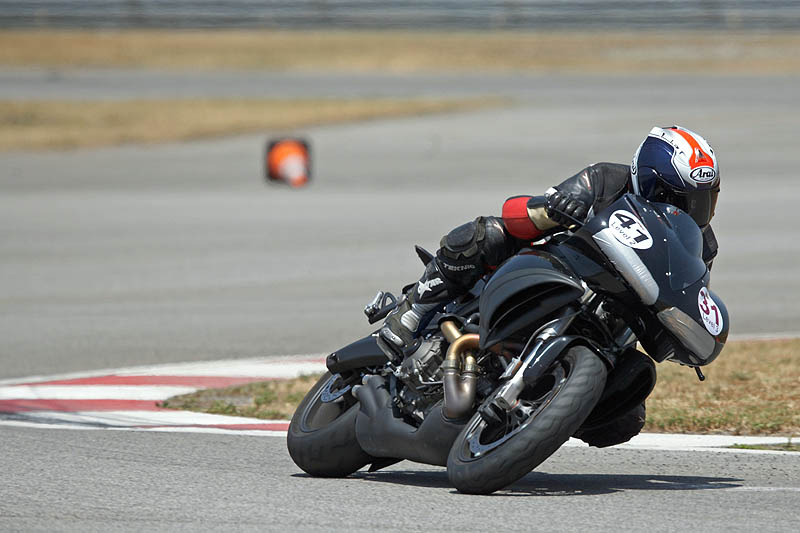
2009 Buell 1125R $12,499
We introduced you to the 1125R a couple of years ago, with a detailed description of the technical innovations packed into this bike. We were impressed by the torquey motor and solid chassis, but we noted quirks in the fuel injection, especially below 4000 rpm. Other, lesser publications also noted problems with both pre-production (like the bikes at the 2007 press launch) and production versions, so last year the Helicon motor received significant revamping. New injectors, relocated O2 sensors, and updated electronics are claimed to improve drivability below 6000 rpm, as well as helping the bike run cooler.
Out on track, all three of us were enamored by the smoothly fueled and hard-charging motor. “It will grunt out of a corner as low as 5500 rpm, and rev out to its 10500 rpm redline with equal enthusiasm,” said Babbit, and Jeff noted it pulls very well down low and revs out nicely with no “hits” anywhere,” plus he thought the revamped FI felt “almost perfect,” giving the rider confidence to get on the throttle earlier coming out of tight corners. And that whoosh of thrust didn’t let off, all the way to the 10,500 rpm redline.
The transmission, we all agreed, was serviceable, never missing a shift, but had an old-fashioned feel, with a longer throw and more clunking than the Japanese Fours. Babbit noted the slipper clutch didn’t do much for him, not slipping much at all and causing chatter that made him occasionally run wide entering corners.
At least we all liked the chassis. The bike looks and feels big, but it’s surprisingly nimble, yet stable at the same time. Jeff said it “was a breeze to ride” once you adjusted to its vagaries, and Babbit noted in his oddly Melville-esque way how in high-speed sweepers the “Buell remained steadfast, yet would happily alter course at my whim with little effort.” Just call him Ishmael. We also liked the suspension; Babbit said it worked as well as Kawasaki’s very impressive Big Piston fork found on the ZX-6R, and I could find no fault with it after I added more rebound damping.
Babbit and Jeff liked the ZTL rim-mounted front brake. Jeff expected it would “be a shortfall on the track, but it was exactly the opposite.” Babbit liked the control it offered: “I could bring the OE front tire right up to where it would cry uncle, but not go beyond.” Me, I can’t fault its level of power and control, but I did note its tendency to stand the front wheel up, and by the end of the day the brake lever was coming in closer to the bar than the other two bikes.
Another niggle we noted was vibration. The bike buzzes at high rpm, which is where the motor works the best. “It’s always there,” said Babbit, “and it’s strong enough to make the tach needle appear ‘wider’, making a shift at redline more of an approximate guess.” At lower speeds and on the street it’s not an issue, but jeez…the inline Fours vibrate less than a triple-counterbalanced V-Twin? Hell of a world we live in, no?
Overall, the Buell was really easy to ride. It was a great learning tool for me to get acquainted with Fontana, and our vets appreciated its comfort, character and flexibility. But was it clearly faster than the other bikes? Not if you go by our laptimes: only Babbit was consistently faster on it, even though we all thought we could get on the gas slightly quicker exiting corners on the V-Twin.
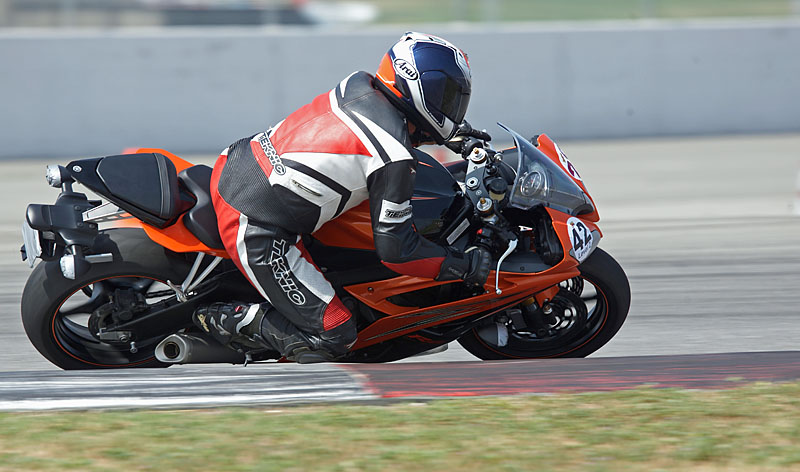
2009 Yamaha YZF-R6 $9990
Back in 2006, Yamaha introduced the focused, high-revving and all-new YZF-R6, and it immediately got a reputation for being tricky to ride, peaky, and rewarding for experts. It got another overhaul for 2008; you can read our tech report and riding impressions to get the bloody details, but basically Yamaha honed an already razor-sharp instrument, most notably adding the YCC-I variable-intake system to improve low and midrange drivability.
So is it even sharper than ever? Yes and no. Babbit found the motor still lacking in midrange while not having the top-end power he remembered, and the gear ratios made it difficult to find the right gear at Fontana. The seating position sits you further forwards than the other bikes, putting your weight over the front end and the bike out of your view. “It all works together and you feel utterly plugged in,” said Babbit, but he didn’t see the need for such aggressive ergos after going equally fast on the more-humane Kawi and Buell.
The R6 rewards an expert racer, and nowhere is that more evident than the suspension. As delivered, Babbit found it rode too high in front and too low in the rear, with not enough rebound in the shock. He and Jeff went to work, tossing suspension terms at each other as they busily twirled the 12 separate suspension adjusters (each fork leg has separate high and low-speed compression circuits, as does the rear shock). “Crank down the hammenjammer! Fraggle out the beemensterf dial! We need 9.4 more clicks on the forward yarbenstaff horgle!” But at the end of it all, they seemed satisfied with the suspension settings. Babbit reported it was less likely to wag its steering-damperless head over bumps, and Jeff said it was the “best-handling bike here.” I found a bike that turned quickly, almost without thought, yet felt stable in high-speed stuff, but I had a hard time keeping up a fast pace on it. Jeff, on the other hand, found himself going the fastest on the R6. Babbit faulted the brakes – which we all agreed were the softest of the bunch, perhaps due to pad choice – and the technological advantages of the newer designs for his slower times on the R6.
We all enjoyed riding the R6, but it definitely doesn’t have the broad appeal and ease-of-use that the other two bikes showed. But in the right hands, it can still set the best times – or get on an AMA podium.
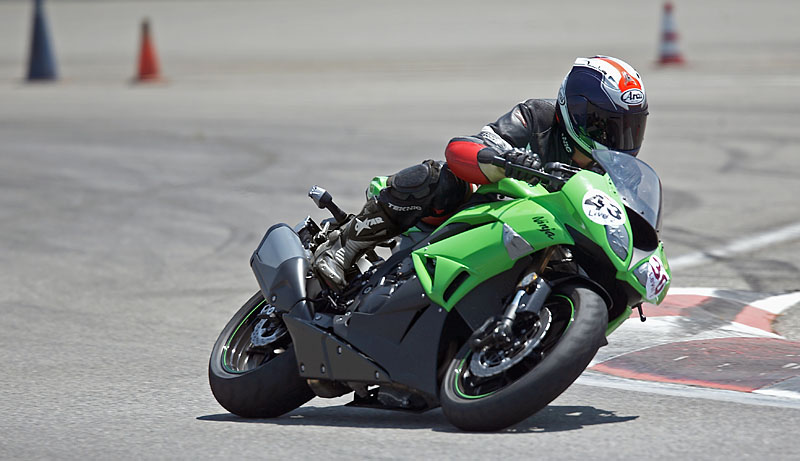
2009 Kawasaki ZX-6R $9799
If there is any consumer product that comes close to perfection, it’s the middleweight sportbike. And that’s no surprise, considering the close competition and multiple demands made on product planners and engineers. Not only do these machines need to be light, fast and handle well enough to win races all over the world in a dozen or so of different race series, they also have to be pleasing to scads of street riders with varying skills and needs.
Luckily for all of us, millions, if not billions of dollars have been poured into developing these things over the past few decades, resulting in perfectly baked goodies that appeal to all tastes. Example: Kawasaki’s new-for-2009 ZX-6R. We sent Mr. Winfield over to The Home Islands last year to ride the new bike; you can read about the techie stuff in his first-ride story. He reported a smooth, fast and sweet-handling platform that made more power and weighed an amazing 22 pounds less than the 2008 model.
And that’s just what we found as well. It felt as compact as the R6, yet it somehow manages to be roomy and comfortable for the smaller frames of Babbit and me, or the hulking man-bear shape of Jeff. The motor is smooth, powerful and revs easily – although the R6 has more meat in the top of its powerband – and the clutch and gearbox add to the bike’s refined and sophisticated feel.
The chassis is just as good, and we all dug the new Big Piston fork. It’s easy to toss around through left-right transitions, yet is stable and solid in high-speed turns; good news for me as I experimented with carrying more speed through the 110-mph chicane coming off the Speedway’s banking. And that front fork! Jeff and Babbit both raved: “The best stock forks I have ever experienced,” gushed Jeff, and Babbitt liked how the fork was both compliant in turns and resisted brake-induced dive. The rear shock was the literal soft spot for Jeff: he noticed it overheating on the track, but he is a big guy, after all. As for me, I noticed that not only did I ride the fastest lap on the ZX-6R, I was also consistently faster on it than the other bikes. An odd fly in the ointment was the pretty Öhlins steering damper mounted over the tank. It looks nice, but is set very soft, and clicking the adjusters has little effect. “Put the OE version on your screen door and get the “real” one,” said Babbit. Luckily, the ZX-6R is so stable and collected that it hardly needs a damper, especially at trackday and street speeds.

Racetrack Conclusions:
So who is the clear winner on the racetrack? After all, a high-speed venue like Fontana should reward the fastest bike, no? Actually, no. I felt most comfortable on the Buell, but set my best times on the Kawi. Babbit liked the Kawi the most (like I did), but went fastest on the Buell (by a fraction of a second). And Jeff loved the riotous, bad-boy nature of the Yamaha, picking it as his track toy, going almost 2 seconds a lap faster on it than the Buell.
Of course, three yahoos doing a trackday on stock tires is hardly an objective test of these three machines’ capabilities, but it did give us a little insight. Most riders will find it easier and less fatiguing to ride the Buell, with its ability to drive hard off corners in almost any gear. And the Kawi’s flexible motor and excellent chassis make it almost disappear beneath the rider, letting him focus on the perfect lap. The Yamaha is an expert’s mount that yields rich rewards to the rider who has set it up perfectly and can exploit its strengths.
But what would have the clear advantage in a race? Given equal preparation and riders, I wouldn’t bet more than a sawbuck on any one. It does seem that the Buell would be easier on both the rider and tires, but that could be a small edge. Of course, sometimes that’s all you need.

On the Street
Racebikes are cool to watch on TV, but for most of us it’s Win on Sunday, Ride to Work on Monday, with weekend rides and occasional trackdays to blow out the cobwebs. So we also spent some time riding public roads.
Again, the advantages and disadvantages are murky, but clearer than on the track. For instance, the Buell is clearly the winner for street comfort. The bars are high, the seat is cushy, it’s got good fuel range and wind protection is more than ample, thanks to that flying saucer bolted in front of the tank that Buell calls a fairing. The motor is now nicely fuelled below 6000 rpm, so you can enjoy the torque without getting into the buzzy part of the powerband. “It was far easier to ride on the street than at the race track,” reports Jeff. “It makes a perfect do-it-all type of bike that is happy as a commuter, trackday ride, or weekend warrior.”
I spent a lot of time on a street ride chasing (okay, following 5 minutes behind) Jeff up Palomar Mountain while riding the R6, and it really got me thinking about middleweight sportbikes. The R6 has a demanding seating position, peaky powerband and razor-sharp handling that will punish an inexperienced, ham-handed rider. This is a bike designed by expert riders for expert riders, and for novices to select this bike over an R1 is like recommending an F-15 over an F-16 because it’s one number lower. But for an expert rider, in the canyons, the R6 is a tremendous amount of fun, capable of beating the vehicle code into a helpless, mewling mess. It’s also got great styling and sounds terrific when the tach climbs towards redline.
The ZX-6R is somewhere between these two extremes, right in my sweet spot. It’s as forgiving and easy to ride on the street as it is on the track, and that fork works well on bumpy two-lane roads. It’s got enough torque so it doesn’t feel like a 600 when you roll on in top gear, but it has a top-end hit that’s plenty entertaining. Comfort isn’t bad, if not exactly to sport-tour standards.
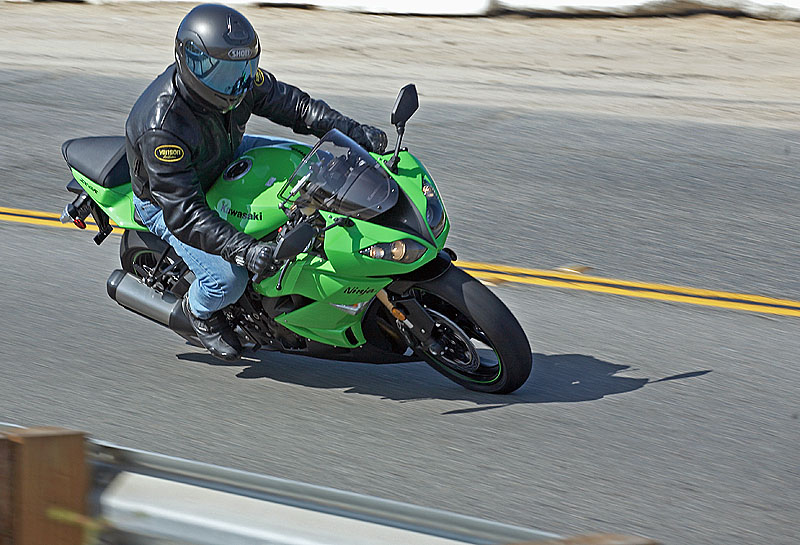
The Winner?
Just like consumers, race teams consider operational costs, rider’s needs, and other factors when they select a bike, and from our cursory research, we could find no clear winner. Want comfort, competence in a unique, roomy package? Buell’s the way to go. Do you want a no-compromises road racer you can rail on the track with and then ride (quickly) to work? An R6 is a fine choice. Something in a lightweight 600 package that can seemingly do it all? We were roundly impressed by the ZX-6R.
Sure, the new racing rules seem to favor the Buell, but let’s not forget other bikes with displacement advantages are also in the class, with not as good a showing. After riding the three bikes both on the street and on the racetrack, we found capable motorcycles, but no clear winner. When you get down to it, it’s all about the rider. May the best man win.
MD Readers Respond:
- Great article – I really enjoyed the real world look at these bikes.
BTW – best line right here:
“The R6 has a demanding seating position, peaky powerband and razor-sharp handling that will punish an inexperienced, ham-handed rider. This is a bike designed by expert riders for expert riders, and for novices to select this bike over an R1 is like recommending an F-15 over an F-16 because it’s one number lower.”I can’t tell you how much I agree. Brian
- I was surprised to hear you all weren’t faster on the Buell, seems like you could make up for a lot of mistakes with those cc’s, but apparently not. I am surprised that the Ducati 848 is considered to be on a par with the 1125, that sort of discounts the effort Buell put together to make a bike to beat the Japanese. After all last year the 1000cc Ducati twins were beating the 1000cc in-line 4’s in WSB. Well I suppose getting it in a class in which they can do well is part of the marketing strategy. Still doesn’t seem fair to me, but they aren’t running away with the races.
Always enjoy your reviews Gabe. Thanks, Bryan

